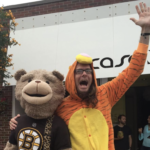
Monthly guide to Boston’s music and arts underground reaches milestone issue
“Directing you to underground shows and awesome happenings! in Boston.” That’s what Sam Potrykus scrawled across the top of the first edition of the Boston Compass.
The publication debuted on March 6, 2010, as just a single photocopied sheet of paper. Each month since, the Compass has arrived as a sort of oracle. The broadside grew into a newsprint newspaper. It was a magical window into a far-out, fringe, independent, underground world of secret house shows filled with fuzzy garage rock and experimental noise—that the police were trying to infiltrate and shut down.
“People who have no voice or no platform or no foundational support, we are a place for them,” Potrykus says. “It’s literally navigating you to something you otherwise can’t get to. That’s why it’s called the Compass.”
Eight years later, and with the help of dozens and dozens of volunteers over the years, the Compass has reached its 100th issue and Potrykus and friends (including his partners at the promotion and event arm Boston Hassle and complementary nonprofit Brain Arts) are celebrating the Compass Centennial. There will be a free party featuring DJs, snacks, beer, and a “fashion photo booth” at the Garment District in Cambridge from 6 to 9 pm Thursday, May 31.
Key to the Compass’s longevity is the partnership Potrykus formed with Dan Shea. Shea already had his own culture blog, Bodies of Water Arts and Crafts. He had a music label and was booking house shows in Jamaica Plain. In 2009, they collaborated to organize the Homegrown music festival, which they now consider the first annual Hassle Fest.
Together the two founded Boston Hassle, an arts site that includes the Compass plus more. Potrykus recalls, “Dan had the blog and I had the newspaper, and maybe a year later we said, ‘Maybe we should make this a thing.’ We sat around thinking of names. We said everything is such a hassle to do arts and culture in this town. So we decided to own that struggle.”
Last year, they launched their umbrella nonprofit Brain Arts. In addition to the publications, last year they produced more than 100 shows around Greater Boston. They also host a bimonthly Black Market flea market and, since January, run the Dorchester Art Project gallery and studios in Boston. The Compass debuted during a moment when underground DIY venues thrived across Boston—the Whitehaus in Jamaica Plain and Gay Gardens, the Butcher Shoppe and Problem House in Allston. These basement and house shows helped incubate bands like Quilt and Guerilla Toss.
“I knew it was big,” Potrykus says. “There were house shows everywhere. I lived at the Whitehaus at the time. There was this great scene, great groups of people. And I saw it all over town. … I was inspired by these crews of freaks, these independent people.”
In a digital era, the Compass was a rare new print publication. Potrykus was inspired by the 1960s San Francisco underground rock publication, Mojo Navigator, while Emma Leavitt, now designer in chief of the Compass, says, “It’s definitely a continuation of some shit that’s way before us—the independent press. It’s becoming more relevant now, especially as our faith in Facebook and social media is crumbling.”
Potrykus quotes punk cartoonist Gary Panter’s 1980 “Rozz Tox Manifesto”: “If you want better media, go make it.”
“I think I did have these grandiose concepts,” Potrykus says. “Man, if there was just one sheet of paper where Cambridge kids, the Allston kids, the JP kids could all be together … I thought I could change the world in some way.”
From the beginning, the heart of the Boston Compass has been its listings—the first edition directed readers to shows by Debo Band and Lightning Bolt drummer Brian Chippendale’s solo project Black Pus. The broadside mutated into an eight-page-long newspaper from August 2013 to August 2016 featuring music, art, film and comics.
Somewhere in there, all the work of putting the Compass out each month nearly got to be too much for Potrykus: “I was about to fold the paper. I was at the end of my rope. Is it even worth it?”
The Compass published an ad seeking help. Along came Emma Leavitt. They met at an Allston cafe. “I almost cried,” Potrykus remembers.
“Sam had his head down on the table,” Leavitt recalls. “He’s like, ‘It’s not worth it.’ I was like, ‘I think it is worth it.’”
Leavitt increasingly took over management of the design and together—with the help of many, many volunteers—they’ve continued on. They eventually reduced the newspaper to four pages a month to make it more manageable. Potrykus says, “Still no one else is covering independent shows that happen in churches and alternatives spaces.”
“I’ve heard from a lot of people that they moved to Boston, they don’t know what’s going on,” Leavitt says. “Then they find the Compass and they’re like, ‘This literally introduced me to all my friends.’”
Greg Cook runs the Wonderland blog (https://gregcookland.com/wonderland/) and is scheduled to begin painting a mural in Salem's Punto Urban Art Museum in October (http://puntourbanartmuseum.org).

